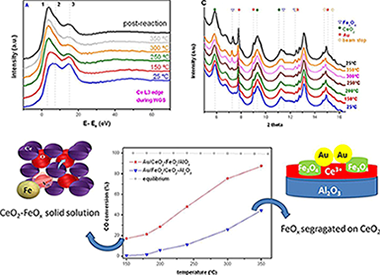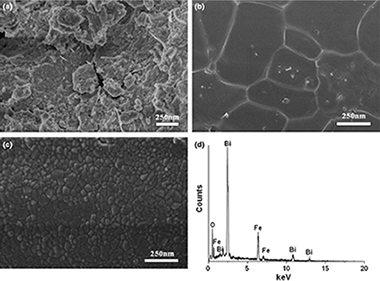Artículos SCI
2013
2013
Materiales Ópticos Multifuncionales
Angular response of photonic crystal based dye sensitized solar cells
López López, C.; Colodrero, S.; Calvo, M.E. and Míguez, H.Energy & Environmental Science, 6 (2013) 1260-1266
Show abstract ▽

Herein we report an experimental analysis of the performance of photonic crystal based dye solar cells (PC-DSCs) as the incident light angle moves away from the normal with respect to the cell surface. Nanoparticle multilayers operating at different wavelength ranges were coupled to the working electrode of a dye solar cell for this study. The interplay between optical and photovoltaic properties with the incident light angle is discussed. We demonstrate that an efficiency enhancement is attained for PC-DSCs at all angles measured, and that rational design of the photonic crystal back mirror leads to a reduction of the photocurrent losses related to the tilt angle of the cell, usually labeled as cosine losses. Angular variations of the cell transparency are also reported and discussed. These angular properties are relevant to the application of these solar devices in building integrated photovoltaics as potential window modules.
Abril, 2013 | DOI: 10.1039/C3EE23609A
Química de Superficies y Catálisis
In situ characterization of iron-promoted ceria–alumina gold catalysts during the water-gas shift reaction
Reina, TR; Xu, WQ; Ivanova, S; Centeno, MA; Hanson, J; Rodriguez, JA; Odriozola, JACatalysis Today, 205 (2013) 41-48
Show abstract ▽

In this work an in situ XRD and XANES study of two gold catalysts supported on iron-promoted ceria–alumina carriers was carried out during the water-gas shift reaction (WGS). The first catalyst, Au/CeO2–FeOx/Al2O3, was prepared using a commercial alumina support in order to obtain a Ce–Fe oxide solid solution and in the second one, Au/FeOx/CeO2–Al2O3, an iron oxide monolayer was deposited onto a ceria–alumina commercial support to promote its redox properties. Catalytic activities in the WGS were remarkably different for both systems. The catalytic activity of the Au/CeO2–FeOx/Al2O3 catalyst was higher than the one shown by the Au/FeOx/CeO2–Al2O3 catalyst that resulted active at much higher temperatures. In situ XRD demonstrates the formation of magnetite (Fe3O4) during the WGS reaction and the presence of big gold particles, ca. 21 nm in diameter, in the low-activity system. This in contrast to the high-activity system that shows undetectable gold nanoparticles and the absence of diffraction peaks corresponding to magnetite during the WGS. The data obtained using in situ XANES states that Ce4+ species undergo reduction to Ce3+during the WGS for both catalysts, and also confirms that in the high-activity catalyst iron is just present as Fe3+ species while in the low-activity catalyst Fe3+ and Fe2+ coexist, resulting in iron spinel observed by XRD. These results allow us conclude that the Au/CeO2–Fe2O3/Al2O3 catalyst is a suitable catalyst for WGS when avoiding the formation of magnetite, in such a case Fe3+ species favors reduction and water splitting increasing the catalytic activity in the WGS reaction.
Abril, 2013 | DOI: 10.1016/j.cattod.2012.08.004
Nanotecnología en Superficies y Plasma
Growth of SiO2 and TiO2 thin films deposited by reactive magnetron sputtering and PECVD by the incorporation of non-directional deposition fluxes
Alvarez, R; Romero-Gomez, P; Gil-Rostra, J; Cotrino, J; Yubero, F; Gonzalez-Elipe, AR; Palmero, APhysica Status Solidi (a), 210 (2013) 796-801
Show abstract ▽
We have deposited TiO2 and SiO2 thin films by techniques as different as plasma-enhanced chemical vapor deposition (PECVD) and reactive magnetron sputtering under experimental conditions where highly directional deposition fluxes are avoided. The results indicate that whatever the deposition technique employed or even the precursor gas in the PECVD technique, films share common microstructural features: a mounded surface topography and a columnar arrangement in the bulk, with the column width growing linearly with film thickness. With the help of a Monte Carlo model of the deposition, we conclude that these common aspects are explained by solely taking into consideration the incorporation of a low-energy, isotropically directed, deposition flux onto a substrate at low temperature and under a weak plasma/surface interaction environment.
Abril, 2013 | DOI: 10.1002/pssa.201228656
Química de Superficies y Catálisis
Au/TiO2 supported on ferritic stainless steel monoliths as CO oxidation catalysts
Milt, VG; Ivanova, S; Sanz, O; Dominguez, MI; Corrales, A; Odriozola, JA; Centeno, MAApplied Surface Science, 270 (2013) 169-177
Show abstract ▽

Metallic supported structured catalysts were obtained by washcoating AluchromYHf monoliths with an Au/TiO2 catalyst. The powder catalyst was synthesized by DAE (direct anionic exchange) method. Using this catalyst, a stable slurry was prepared and used to washcoat the monoliths. TEM and SEM studies revealed that gold nanoparticles in the Au/TiO2 powder catalyst had an average diameter of 3–4 nm, but during the preparation of the structured catalyst, aggregate Au particles of the slurry reached diameters of 9 nm. Before coating, Aluchrom YHf monoliths were thermally treated to generate a homogeneous and well-adhered oxide rough surface layer, mainly composed of α-Al2O3 whiskers, which favored the anchoring of the catalyst. The catalytic layer deposited was well attached and contained not only the Au/TiO2 catalyst but also metallic oxides formed from stainless steel components that diffused through the oxide scale. The structural characterization was performed by XRD, XRF, TEM, SEM, GD-OES and SBET.
The catalytic activity of the powder and structured catalysts was tested in the oxidation of the CO reaction. Catalysts demonstrated to be active at room temperature. After a first activation run, and in spite of their larger gold particle size, the catalytic activities of the structured catalysts overcame those of the powder catalyst. This improvement is probably due to the segregation of the transition metal oxides toward the surface oxide scale.
Abril, 2013 | DOI: 10.1016/j.apsusc.2012.12.159
Reactividad de Sólidos
Electrical Properties of Stoichiometric BiFeO3 Prepared by Mechanosynthesis with Either Conventional or Spark Plasma Sintering
Perejon, A; Maso, N; West, AR; Sanchez-Jimenez, PE; Poyato, R; Criado, JM; Perez-Maqueda, LAJournal of the American Ceramic Society, 96 (2013) 1220-1227
Show abstract ▽

Phase-pure powders of stoichiometric BiFeO3 have been prepared by mechanosynthesis. Ceramics sintered by either conventional heating in air or spark plasma sintering (SPS) followed by oxidative anneal in air are highly insulating at room temperature with resistivity, extrapolated from the Arrhenius plots, of ~1016 Ωcm and activation energy 1.15(2) eV, comparable with those of a good-quality BiFeO3 single crystal. By contrast, the as-prepared SPS sample without the postsinter anneal shows lower resistivity, e.g., ~1010 Ωcm at 25°C and activation energy 0.67(3) eV, indicating some reduction in the sample by the SPS process. The reason for the high conductivity reported for some ceramic samples in the literature remains unclear at present.
Abril, 2013 | DOI: 10.1111/jace.12186
- ‹ anterior
- 307 of 422
- siguiente ›














